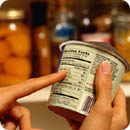 What do bread, crackers, cereal, macaroni & cheese, frozen pizza, donuts, and cookies have in common? Besides being at the top of the list of many people's favorite foods, they are all possible sources of trans fats. Trans fats are oils that have been chemically-altered (through a process called hydrogenation) from their original liquid states, into solid shortening. The process increases the shelf life of the oil and improves the texture of the food to which the oil is added.
What do bread, crackers, cereal, macaroni & cheese, frozen pizza, donuts, and cookies have in common? Besides being at the top of the list of many people's favorite foods, they are all possible sources of trans fats. Trans fats are oils that have been chemically-altered (through a process called hydrogenation) from their original liquid states, into solid shortening. The process increases the shelf life of the oil and improves the texture of the food to which the oil is added. However, when you add those foods to your grocery cart, you're increasing your risk of heart disease because trans fats are artery-clogging professionals. In fact, the Nurse's Health study of 80,000 women found that a 2% increase in trans fat consumption increased a woman's risk of heart disease by 93%. Take a stroll down the cookie or snack aisle of your local grocery store and you'll see "No Trans Fat" or "Now with Zero Trans Fats" splattered all over food packages. If you find yourself wondering what the heck trans fat is, how it got into your food in the first place, or why it's gone now, then read on to find the answers to these questions and more. What is trans fat? Trans fat is created through a process called hydrogenation, which adds hydrogen molecules to highly unsaturated (liquid) oil, such as vegetable oil, corn oil, or soybean oil. After hydrogenation, the oil is called "partially hydrogenated" when listed on the package's ingredients list, and it contains trans fats. Why do manufacturers use hydrogenated oils? Years ago, manufacturers predominately used animal fats such as lard, beef tallow, and butter when making baked and fried foods. Later, when scientists discovered that these saturated fats contributed to heart disease and "bad" (LDL) cholesterol levels, food companies started looking for alternatives to these saturated fats. Hydrogenation makes oils more stable and solid at room temperature. This improves the baking characteristics of the liquid oil as well as the taste and texture of the end product. Partially hydrogenated oil provided a good alternative when it came to taste, texture, and stability, and manufacturers started using these oils instead of animal fats. Years later, scientists discovered that both saturated fat and trans fat increase the risk for heart disease. Which products contain partially hydrogenated oil and trans fat? Food products that contain trans fat include vegetable shortenings, harder stick margarines, crackers, candies, cookies, snack foods, fried foods, doughnuts, pastries, baking mixes and icings, and store-bought baked goods. You may think that trans fat primarily comes from margarine, but margarine accounts for less than 20% of the trans fat in the average American's diet. Some meats and dairy products naturally contain small amounts of trans fat. Continued › |
Translating those Trans Fats
Understanding and Avoiding these Unhealthy Fats
Page 1 of 2 Next Page ›






Member Comments